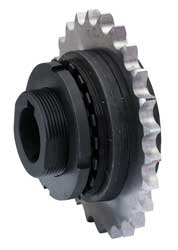
Posted to News on 17th Dec 2010, 10:41
Advantages of mechanical torque limiters over electronic types
Techdrives offers advice on how to select the right mechanical or pneumatic torque limiter for a given applications, and explains the advantages over limiting torque using electronic devices.

Some people today view mechanical torque limiters as old-fashioned and unnecessary, believing that electronic monitoring can meet the needs of machine protection and operator safety. However, what is actually needed is a device to prevent damage from accidental collisions that can lead to expensive downtime. There is also an increasing emphasis on operator safety, as EN ISO 13849-1 demands a higher level of protection than was acceptable before. In these cases the humble mechanical torque limiter remains the optimal answer because it disconnects the drive from the driven parts in a very short time.
Where there is a slow increase in load, for example due to damaged bearings or dirt contamination, electronic sensing can work well; there is time to stop the drive and the signal can be used as a preventative alarm. On the other hand, where the load increase is sudden, for example due to a misfeed or mechanical breakage, only a mechanical torque limiter can give protection. By introducing a disconnection between the motor and the driven load, the torque limiter takes much of the inertial energy out of the drive train. Indeed where the limiter can be positioned at low speed close to the output, practically all the kinetic energy can be disconnected, resulting in a greatly reduced possibility of damage or injury. Disconnection is not instantaneous; depending on the design and size of limiter it can take from single figures to tens of milliseconds. However, electronic systems cannot match this performance as they have to sense the overload and then apply a braking torque to bring the drive train to a stop. Therefore when it comes to achieving maximum protection and safety, mechanical torque limiters remain the only real answer.
Simple friction torque limiters drive using spring-loaded rubbing faces that connect to a driven wheel, often a plate wheel. These friction torque limiters are low cost, easy to adjust steplessly, and react very quickly to shock loads. They do not suit operation in oily environments, or under conditions of prolonged slippage, which introduces wear and the need for readjustment. Therefore they are best used at low speed, positioned close to the output. They are available in a wide range of rated torques from 1 to 23,000Nm.

Many variants are available based on the ball and roller principle. By positioning the rollers asymmetrically, re-engagement will always be in a synchronised angular position. Alternatively, multiple positions - such as every 180 or 60 degrees - are possible. The recesses can be machined to give different torques according to the direction of rotation. Models are available for in-line transmission with shaft couplings, and offset with narrow or wide gears and pulleys. These popular designs are to some extent a European standard product and have ratings from 2 to 12,000Nm.

Generally mechanical torque limiters are set to release at the highest torque required by the drive plus a service factor. In many machines the starting torque is often the highest torque. Setting the torque limiter above this level is necessary to prevent tripping on start-up, but may result in a lack of sensitivity during the normal working part of a machine cycle. The ability to easily adjust the release torque during a cycle, or perhaps for a different product running on a machine, is an advantage contributing to a higher degree of protection. Electronic monitoring can easily handle different levels of torque but, as mentioned above, does not give the disconnection. The torque limiter solution to this problem is to use pneumatic actuation.

Over the years mechanical torque limiters have been developed to suit a number of market niches. Linear force limiters trip when a set force is exceeded either in tension or compression and are frequently used as gearbox torque arms. A pneumatic friction design suits simple tensioning applications, as the pneumatic cylinder automatically compensates for wear on the friction linings. Roller types can be supplied to give an overload signal without disconnecting the drive, which is a useful feature where the load might otherwise fall. Every application has individual requirements for protection and sensitivity. Where operator safety is a factor, higher standards are needed and advice from experienced suppliers is recommended. The new safety standard EN ISO 13849-1 requires machine designers to re-assess hazards, although, as a standard related to control systems, it does not specifically deal with torque limiting. Nevertheless the review process may identify torque limiters as a means of achieving higher safety levels.
Mechanical torque limiters are today available in widely different forms to suit practically all types of machinery. The level of protection achieved depends on the sensitivity and repeatability of the torque limiter. Compared to electronic torque monitoring, mechanical torque limiters offer the important advantage of disconnection where the inertial energy on the drive side is isolated from the output, reducing damage and improving safety. A complete range of torque limiters manufactured by ComInTec is shown on the Techdrives website www.techdrives.co.uk, or follow the links in the text above.
Want the latest machine building news straight to your inbox? Become a MachineBuilding member for free today >>
Lenze Selection (a Division of Lenze Ltd)
6 Abbey Court Road
Priory Business Park
MK44 3WH
UNITED KINGDOM
+44 (0)1234 753201

















